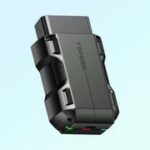Yes, every Dodge Ram 3500 manufactured since 1996 has an OBD2 port. This includes all models, including diesel and gasoline engines. The OBD2 port location may vary slightly depending on the year and model, but it is typically found under the dashboard on the driver’s side, near the steering column.
Where to Find the OBD2 Port on a Dodge Ram 3500
The OBD2 port on a Dodge Ram 3500 is usually located under the dashboard, on the driver’s side. It’s often near the steering column or in the area where your left knee would be while driving. Here’s a more specific breakdown based on common locations:
- Under the Steering Column: This is the most frequent location. Look for a trapezoidal-shaped connector hanging down or recessed slightly into the dashboard.
- Near the Fuse Box: Sometimes the OBD2 port is located near the fuse box, which is also typically found on the driver’s side under the dash.
- Along the Center Console: In some rare cases, the port might be positioned along the lower part of the center console, closer to the passenger side.
If you’re having trouble locating the port, consult your owner’s manual. It will provide a diagram or specific instructions for finding the OBD2 connector in your particular model year.
Why is the OBD2 Port Important?
The OBD2 port, short for On-Board Diagnostics, is a standardized system that allows external devices to access diagnostic information from your vehicle’s computer. It’s a critical component for:
- Emissions Testing: Smog Check inspections use the OBD2 port to verify that the vehicle’s emissions control systems are functioning properly. Specific readiness monitors within the system are checked for completion.
- Troubleshooting: Mechanics utilize a scan tool connected to the OBD2 port to read diagnostic trouble codes (DTCs). These codes pinpoint malfunctions within the engine, transmission, and other systems. The port also allows access to live data streams, enabling mechanics to monitor sensor readings and other parameters in real-time.
- Performance Tuning: Aftermarket performance tuners often use the OBD2 port to modify engine parameters and enhance performance. This can include adjustments to fuel delivery, ignition timing, and other variables.
- Vehicle Monitoring: Devices like code readers and data loggers can be plugged into the OBD2 port to provide real-time information on vehicle performance, fuel economy, and other data.
Common Issues with Dodge Ram 3500 OBD2 Ports
While generally reliable, the OBD2 system in a Dodge Ram 3500, like any vehicle, can experience issues:
- Communication Errors: Sometimes, a scan tool might fail to communicate with the vehicle’s computer. This can be caused by a faulty OBD2 port, damaged wiring, a blown fuse, or problems with the vehicle’s computer itself. Certain model years of the Ram 3500 have known communication issues, often requiring software updates or specific procedures to establish communication.
- Incomplete Readiness Monitors: As mentioned earlier, emissions tests require certain readiness monitors to be complete. Driving habits can sometimes prevent these monitors from running, and some Ram 3500 models have known issues with specific monitors not completing. Consult the official documentation for potential fixes related to specific model years.
- False MIL Illumination: The malfunction indicator lamp (MIL), or check engine light, can illuminate due to a genuine problem or a system glitch. In some Ram 3500s, there have been reported cases of the MIL illuminating without any corresponding trouble codes, often requiring further diagnosis.
What to Do If You Have OBD2 Problems
If you suspect an issue with your Dodge Ram 3500’s OBD2 system:
- Check the Fuse: Consult your owner’s manual to identify the fuse related to the OBD2 port and ensure it hasn’t blown.
- Inspect the Port: Examine the port for any signs of physical damage, such as bent pins or debris.
- Try a Different Scanner: Sometimes, the issue might be with the scan tool itself. Try using a different scanner to see if it can communicate.
- Consult a Mechanic: If the problem persists, take your vehicle to a qualified mechanic who can diagnose and repair the issue. They will have access to professional-grade scan tools and the expertise to pinpoint the problem. They can also access technical service bulletins (TSBs) that address known issues for specific Ram 3500 models. Certain problems may be covered under recall campaigns or extended warranties.
Conclusion
The OBD2 port is a crucial component of your Dodge Ram 3500. Understanding its location, function, and potential issues can help ensure your truck runs smoothly and passes emissions tests without a hitch. If you encounter any problems, don’t hesitate to seek professional assistance.
